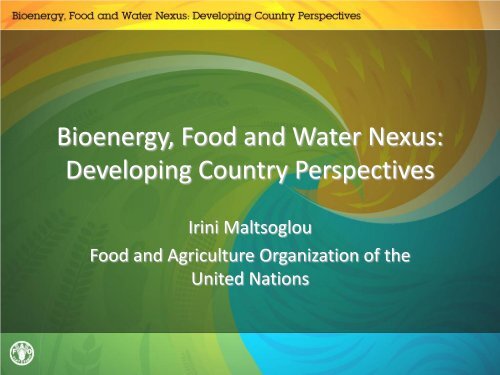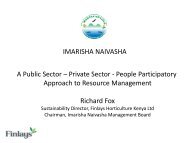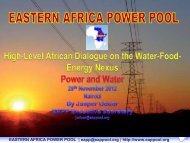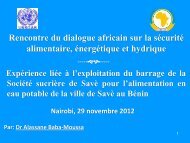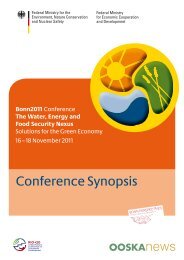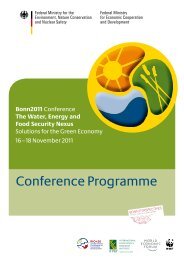Irini Maltsoglou Food and Agriculture Organization of the United ...
Irini Maltsoglou Food and Agriculture Organization of the United ...
Irini Maltsoglou Food and Agriculture Organization of the United ...
- No tags were found...
Create successful ePaper yourself
Turn your PDF publications into a flip-book with our unique Google optimized e-Paper software.
Bioenergy, <strong>Food</strong> <strong>and</strong> Water Nexus:Developing Country Perspectives<strong>Irini</strong> <strong>Maltsoglou</strong><strong>Food</strong> <strong>and</strong> <strong>Agriculture</strong> <strong>Organization</strong> <strong>of</strong> <strong>the</strong><strong>United</strong> Nations
Development challenges <strong>and</strong> prospects• Challenges are mounting for developing countries:– Energy dem<strong>and</strong>, food insecurity, natural resource constraints,climate change, etc.• New development paths must be found:– Sustainable development, low-carbon development, greengrowth (Rio+20), etc.• Can bioenergy help address <strong>the</strong>se challenges?– Yes, in some countries, but only through a “nexus” approach
Bi<strong>of</strong>uels are already exp<strong>and</strong>ing rapidly• Global production is dominated by developed <strong>and</strong> largedeveloping countries (e.g., USA, Brazil)– But more developing countries are exploring domestic options,usually in response to foreign investor interests• Bi<strong>of</strong>uel technologies <strong>and</strong> feedstock are evolving– But <strong>the</strong> current emphasis is on traditional biomass• “<strong>Food</strong>-fuel” debate focuses on global price effects– But many developing countries see bi<strong>of</strong>uels as a developmentopportunity (esp. for rural areas <strong>and</strong> poor households)
...but <strong>the</strong>re are many concerns• Numerous concerns are raised about bi<strong>of</strong>uels– Might worsen water constraints, food insecurity <strong>and</strong>environmental problems• Can bioenergy be developed in low-income countrieswithout worsening food security <strong>and</strong> <strong>the</strong> environment?• Any answer is likely to be case-specific– Countries differ in <strong>the</strong>ir agro-ecological conditions– Development needs <strong>and</strong> food/energy security constraints vary
Sustainable development “nexus”DevelopmentEnergy<strong>Food</strong>Bi<strong>of</strong>uelsWater
Country level assessmentsIdentify country goals <strong>and</strong> objectivesWhat to do?Getting <strong>the</strong> facts right to make<strong>the</strong> right choicesImplementing good practice<strong>and</strong> policiesMonitoring <strong>and</strong> evaluating impacts at country levelSustainability criteria (eg. GBEP sustainability criteria)How to do it?Source: The FAO Support Package for Decision Making for Sustainable Bioenergy, 2011 (www.fao.org/bioenergy )To learn more about FAO programmes:Sustainable crop intensification www.fao.org/ag/save-<strong>and</strong>-grow Coping with water scarcity www.fao.org/nr/waterL<strong>and</strong> Tenure www.fao.org/nr/tenure Climate Change www.fao.org/climatechange
Country level assessmentsCountry analytical framework(FAO’s BEFS-AF)Identify country goals <strong>and</strong> objectives1.Diagnostic (current needs <strong>and</strong> challenges)2. Natural resources (l<strong>and</strong>, water <strong>and</strong> residues)Getting <strong>the</strong> facts right to make<strong>the</strong> right choicesImplementing good practice<strong>and</strong> policies3. Techno-economic <strong>and</strong> environmental(technologies, production costs, greenhouse gasemissions, etc.)Monitoring <strong>and</strong> evaluating impacts at country levelSustainability criteria (eg. GBEP sustainability criteria)4. Socioeconomic (development impacts)What to do?How to do it?
Evidence-based decisions in Tanzania• Which feedstock crops can begrown for bi<strong>of</strong>uels?• Where can <strong>the</strong>y be grown <strong>and</strong>what is <strong>the</strong> l<strong>and</strong> used for?Potential <strong>and</strong> current cassavagrowing areas in Tanzania
Evidence-based decisions in TanzaniaTanzania vs. global supply priceTanzania Ethanol Delivered at Rotterdam• Can bi<strong>of</strong>uels be producedpr<strong>of</strong>itably <strong>and</strong> competitively?10MolassesSugarCassava0 10 20 30 40 50 60 70 80 90 100USD per barrel
GrowthPovertyEvidence-based decisions in TanzaniaGrowth <strong>and</strong> poverty impactsTen-year change in national incomeor poverty rate (%)0 2 4 6Sugarcane (large)Cassava (small)• What are <strong>the</strong> developmentimplications?Sugarcane (large)Cassava (small)
GrowthPovertyTanzania vs. global supply priceConcluding remarksPotential <strong>and</strong> current growing areasGrowth <strong>and</strong> poverty impactsTen-year change in …Tanzania Ethanol Delivered at Rotterdam0 2 4 6MolassesSugarcane …10SugarCassavaCassava …Sugarcane …0 10 20 30 40 50 60 70 80 90 100USD per barrelCassava …• Evidence-based policy is crucial– Impacts vary by country (i.e., case-specific)


